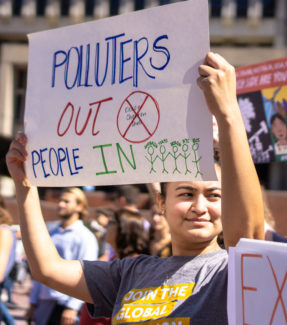What does movement-building mean and look like for those of us deeply concerned about the outsized influence of corporate power in our society?
I have spoken with many of you about how Trump’s election has made the corporate power grab more evident than ever. The actions of the Trump administration have exposed the role and influence of corporate decision-makers in our government — and taken it to a whole new level. In the words of Naomi Klein, it’s a “corporate coup d’état.” Just look at Trump’s Cabinet, his proposed infrastructure plan, and how quickly big polluters, Big Money, gun manufacturers, and other abusive industries have moved in their attempts to eliminate lifesaving federal protections.
But the corrosive influence of transnational corporations has been at the heart of societal problems for decades. Corporations and those advancing a neoliberal agenda have undermined faith in government’s ability to provide essential services. Racism, xenophobia, sexism, and other forms of fear and hatred have long been used by those in power to prevent people from coming together to challenge economic and other injustices.
What is extraordinary about this moment is that these forces are now out in the open.
The curtains drawn back; people activated
The issue of corporate power, although long felt, has also been long hidden from view.
But with the election of Trump, more people than ever before are making the connections between the forces of corporate power and systems of oppression. More and more people are angry. They’re taking action. And we are seeing beautiful bursts of organizing and movement-building.
Our challenge — indeed, our responsibility — is to ensure this energy is both sustained and channeled into strategic action. As social scientist Hildy Gottlieb points out in the Stanford Social Innovation Review, “The word ‘movement’ means ‘to create action,’ to go from one place to another. Sustaining a movement is about sustaining action.”
Shared vision and values
To sustain action as a movement, we need a shared vision of where we are going and a shared set of values that informs how we get there. I am not suggesting we all need to have exactly the same tactics and approaches, nor that we need to have worked out all the solutions. This is inadvisable, not to mention impossible: We need a range of theories and practices to develop innovative and effective solutions for creating a just, sustainable, and equitable world.
What I am suggesting is that we need to do this work grounded in values of justice, equity, and inclusion. A truly sustainable people’s movement must have at its core the goal of dismantling all systemic oppression — together and at once. We cannot, for example, challenge corporate power without at the same time challenging systemic racism.
Strategic action gets to root causes
Which brings us to the need to build a strategic movement. After the election, many organizations provided tools for people to put pressure on elected officials. This has been very successful in helping people understand how to move elected officials. And we need more. We need civic engagement that goes beyond the electoral arena.
We need an inclusive, intersectional movement that challenges the status quo and corporate takeover by the Trump regime. We have to end the corruption of democracy by corporate power and the systems of oppression that allowed Trump and his crony capitalist government to take power.
This will require popular education and mobilization. This is what I consider true civic engagement: hundreds of thousands of people talking with their neighbors, organizing actions, and being part of strategic, organized campaigns with specific goals and targets that add up to big change.
For example, the Trump regime is opening the door for corporations to take control of water infrastructure. We are deepening our work with mayors and other elected officials to keep public control of water. And we are also helping create a nationwide network of people actively organizing in their own communities to protect their water. We are training people on how to talk with their neighbors about the dangers of privatization, how to hold their local officials accountable, how to generate media that raises the visibility of the issue, and other organizing skills.
This is a moment of extremes. The harm being done to so many of us — immigrants, black people, workers, women — is enormous. And so too is the energy and commitment of millions of us across the country who refuse to be complicit. It is our responsibility, as social change makers, to support and build a movement that adds up to strategic power—one that will significantly diminish the influence of transnational corporations over our democratic institutions and lives, as we build a just, sustainable, and equitable future together. I am grateful to do this work alongside you.
Thank you for all you do.







